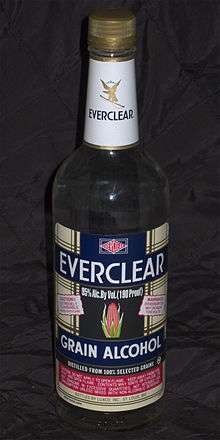Everclear (alcohol)
 A bottle of 190-proof Everclear. | |
| Type | Rectified spirit |
|---|---|
| Manufacturer | Luxco |
| Country of origin | United States |
| Alcohol by volume | 95% or 75.5% |
| Proof (US) | 190, 151 |
| Color | Colorless |
| Flavor | Neutral, contains no flavoring |
| Website | http://www.makeityourown.com/ |
Everclear is a brand name of rectified spirit (also known as grain alcohol and neutral spirit) produced by the American company Luxco (formerly known as the David Sherman Corporation). It is made from grain[1] and is bottled at 151 and 190 U.S. proof (75.5% and 95% alcohol by volume).[2] Due to its market prevalence and high alcohol content, the product has become iconic, with a "notorious reputation" in popular culture.[3] Sale of the 190-proof variation is prohibited in some states.
Consumption
According to the manufacturer, Everclear "should be viewed as an unfinished ingredient", not consumed directly in undiluted form, and the company acknowledges that the product "has a rather notorious reputation" due to its high alcohol content.[3] Rather than consuming Everclear directly, the company says it should be diluted by mixing it with water (to make vodka) or other ingredients until the alcohol strength of the drink is "no more dangerous than other spirits or liqueurs on the shelf".[3] For example, ordinary vodka and gin have an alcohol concentration typically around 40% alcohol by volume (80 proof), and liqueurs are typically around 20% alcohol (40 proof).[3]
Everclear can also be used for extracting flavor from other ingredients to make infusions and tinctures. The company says that Everclear has "an extremely neutral flavor profile" and is "virtually unbeaten in the realm of infusions".[3]
Similar brands
Luxco also manufactures two other brands, Golden Grain alcohol and Crystal Clear alcohol, as essentially the same spirit with a different brand name.[4] Several other brands of grain neutral spirits are also available on the market from other companies.
Alcohol content
Ethanol cannot be concentrated by ordinary distillation to greater than 97.2% by volume (95.6% by weight), because at that concentration, the vapor has the same ratio of water to alcohol as the liquid, a phenomenon known as azeotropy.[5] The 190-proof variation of Everclear is 92.4% ethanol by weight and is thus produced at approximately the practical limit of distillation purity.
Some U.S. states impose limits on the maximum alcohol content allowed for products sold in the state or have other restrictions that prohibit the sale of the 190-proof variation of Everclear in the state.
In popular culture
- In the 1991 rap tune "Ever So Clear", Bushwick Bill of the Geto Boys tells the tale of his night drinking Everclear and getting high on PCP earlier that year that resulted in his eye being shot out. A photo of the incident was used on the cover of the Geto Boys album We Can't Be Stopped, on which the track first appeared.[6] A version of the track on his 1992 solo album Little Big Man reached #1 on the U.S. rap charts.
- The Roger Creager song "The Everclear Song" (written by Mike Ethan Messick and released on the 1998 album Having Fun All Wrong) refers to it.[7]
- The Jerrod Niemann song "For Everclear" on the 2010 album Judge Jerrod & the Hung Jury refers to it.
See also
- Ethanol (ethyl alcohol, drinking alcohol)
- Distilled beverage
- Denatured alcohol
References
- ↑ "Everclear". Luxco official website. Retrieved November 9, 2017.
- ↑ Donn Lux (12 November 2010). "President's Message". Luxco. Archived from the original on 14 July 2011. Retrieved 17 November 2010.
- 1 2 3 4 5 "FAQ page". Everclear official website. Retrieved November 9, 2017.
- ↑ "Neutral Spirits". Luxco official website. Retrieved November 9, 2017.
- ↑ 95.6% according to 49th edition of CRC Handbook of Chemistry and Physics. Perry's Handbook gives 10.57 mole percent water, which is 95.58 weight percent.
- ↑ Staff writers (3 February 2005). "Bushwick Bill Of The Geto Boys Reacts To Houston's Loss Of An Eye". SoundSlam. Archived from the original on 2 December 2010. Retrieved 5 December 2010.
- ↑ Niemann, Jarrod (13 July 2010). "For Everclear". Warner/Chappell Music. Retrieved 19 September 2010.